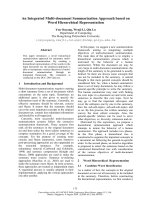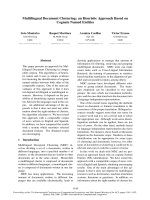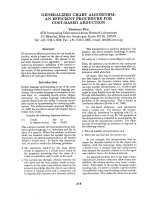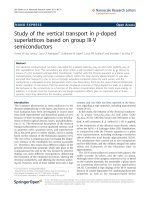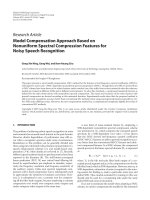An Efficient CNC Programming Approach Based on Group Technology
Bạn đang xem bản rút gọn của tài liệu. Xem và tải ngay bản đầy đủ của tài liệu tại đây (1.54 MB, 5 trang )
An Efficient CNC Programming Approach
Based on Group Technology
Manocher Djassemi, Dept. of Industrial and Engineering Technology, Murray State University,
Murray, Kentucky, USA
Abstract
Many studies and reports support the significant impact of
the application of group technology on various aspects of
product design and manufacturing. The fact that group tech
technology is the common solution to similar problems is the main
source of such impact. In this paper, one of the less frequent
frequently utilized features of GNG technology known as parametric
part programming is used to implement the common solution
feature of group technology in processing a set of similar
parts. Using three part families, the advantages of blending
the concept of group technology and parametric programming
for CNC machining operations are illustrated. The efficiency
improvement due to the use of parametric programming in
terms of number of setups and size of program is discussed.
Keywords: Group Technology, Computer Numerical Control,
Parametric Part Programming
Introduction
Group Technology (GT) is a broad concept that
uses conunon attributes to reduce redundant work in
design and manufacturing and results in shorter
product development and production time. This GT
feature-shorter product development and produc
producmantion time-provides a significant advantage for man
ufacturers by enabling them to respond faster to mar
market demand/changes and run production more eco
economically in today's highly competitive manufactur
manufacturing environment.
A significant amount of research and case studies
in group technology shows that GT improves produc
productivity in one or more aspects. I ,2 The application of GT
covers areas as diverse as design, process planning,
tooling, scheduling, part programming, and material
handling. In all cases, GT is used to find a common
designsolution to a set of similar problems, that is, design
ing similar products or processing similar parts.
allowLikewise, OT is used to classify part designs, allow
ing the efficient grouping of similar designs that can
be manufactured on the same machine or machine
cell. First, the approach avoids duplication of data in
a database; and second, it results in significant reduc
reduc-
tion in both number and variety of CAD files, process
plans, and NC part programs. Many companies in the
US and Europe have adopted OT for standardization
of design and production techniques?
This study is focused on the implementation of the
GT concept to a specific aspect of computer-aided
promanufacturing, that is, numerical control (NC) pro
gramming of machining and turning centers. The
common solution for similar problems (CSSP) fea
feacapabilture of GT and the parametric programming capabil
ity of computer numerical control (CNC) machines
will be used to develop a single NC program for each
part family. For CNC machine users, the combina
combination of CSSP and parametric programming
approaches is expected to create the opportunity to
generate NC codes and operate CNC machines with
greater efficiency. CNC machining or turning centers
lend themselves to the CSSP concept in two ways:
common tooling and common programming for a
family of parts. When a family of parts is processed
on these machines, tool indexing and
loading/unloading are performed less frequently
because most parts can be machined by a set of
common tools. Similarly, the parametric program
programming feature of modern CNC machines allows a
common program to be used for machining a number
of similar parts.
Considering the potential benefits of such an
application for group technology and CNC machine
users, a study to link the parametric programming
technique to OT system is appropriate. Using three
examples, the efficiency improvement due to the
joint application of the two technologies is discussed
in the following sections.
Parametric Part Programming
Traditionally, separate part programs are written for
individual parts within a part family; then the pro
programs are loaded to the machine controller one by one.
Most CNC machines have a special feature known
as parametric programming, also referred to as
macro,4 in which a part program can be written using
variables and parametric expressions to represent the
machine axis position (x, y, z, a, etc.), feed, and speed
functions. s Similar to computer programming lan
languages such as Pascal or C, computer-related features
such as variables, arithmetic, logic statements, and
looping can be implemented in a parametric program.
This programming feature allows the user to load a
single part program for a family of parts to the CNC
controller. The part program is then called up for
machining a similar part or similar feature on differ
different parts. The process involves a simple entry of para
parameter values into the machine controller. For example,
several cylindrical parts may have two common para
parameters, such as diameter and overall length. A single
parametric part program can be called up fi'om a main
program for machining such a group of similar parts.
Upon loading the main program, the values of the two
parameters are entered; then these values are trans
transferred to parametric subprograms. This approach
could minimize the number of program changeovers,
reduce the redundant codes in the part program, and
shorten the length of the program.
Methodology
In this study, three part families are considered to
investigate the effects of blending CSSP and para
parametric programming in improving the efficiency of
CNC operations. The efficiency improvement is
determined based on two factors: (a) number of pro
program changeovers and (b) number of NC files and
size of part program. As the number of part types
within a part family increases, the number of program
changeovers or setups is expected to increase. The
number of NC files and the size of the part program
can have a significant effect on file management and
memory space when the number of part types within
a part family is relatively high. Based on the afore
aforementioned factors, an efficiency improvement (EI)
measure is defined as follows:
n� is the part family size
n
Ni�i is the number of NC instructions (lines) in the
conventional NC program for a part type i in the
family
P is the number of NC instructions (lines) in the
parametric program for the same part family
W is the weight factor
The methodology consists of the following steps:
Step 1. Develop CAD files for the three part
families.
Step 2. Generate NC codes using CAD/CAM soft
software 6 for the parts' CAD files.
Step 3. Write a single parametric program for each
part family.7
Step 4. Compare the two types of part programs
developed in steps 2 and 3 using the EI
measure.
The weight factor, W, is empirically determined
using a Bridgeport CNC mill and a PC. It was
observed that the ratio between the times to change
programs, including clearing the control memory,
and locating a program to program downloading time
from a PC to CNC is roughly 4:1 (W == 80%). This
indicates that for the cases studied here, the effect of
program length on EI is not as significant as the
effect of machine stoppage for program changing
(see Table 1).
Analysis of Results
Part family I consisted of five parts (n == 5), as
illustrated in Figure 1. A single parametric part pro
program for machining this part family is shown in the
Appendix.
The numbers of instructions in conventional NC
programs for individual part types were 66, 37, 132,
104, and 132. The number of executable NC instruc
instructions in the corresponding parametric program was
45 lines. The overall EI due to application of paraTable 1
Program Changeover and Downloading Times (seconds)
n-l
(I~I Nln)-P
EI==-*W+ I I
EI==-*W+�
*(1-W)
n
Part Family
III
II
(1:,;' NJn)
Changeover time
Downloading time
where
40
11
35
8
27
27�
8
8�
Figure 1
ParI Family I
Figllre 3
Part Family III
Figure 2
Part Family II
nummetric programming was 74%. However, if the num
ofpart
part types in the part family grows and the new
ber of
part members are different from the old ones only in
proterms of values of specified parameters in the pro
gram, such as diameter and overall length, then EI
yields greater efficiency in programming the CNC
machine. For example, for 15 part types (n ;=: 15) the
EI increases from 75% to 85%.
Part family II consisted of four parts (Figure 2).
The number of NC instructions for individual part
types were 27, 53, 8, and 34 lines for this group. The
number ofNC instructions in the corresponding para
parametric program was 25 lines (see the Appendix). The
use of parametric programming resulted in a 64%
improvement in programming efficiency. When a
larger number of similar parts (n = 15) were included
by changing the value of the parameters, including
external radius, thickness, diameter of center pocket,
and number of
ofholes,
holes, then the EI improved from 64%
to 78%.
Part family III consisted of four parts (Figure 3).
The number of NC instructions in the conventional
part program remained at 53 for all part types. The
number of NC instructions in the corresponding para
parametric program was 25 lines. The use of parametric
proprogramming resulted in a 64% improvement in pro
gramming efficiency for this part family. By changing
the value of four parameters, including length, width,
thickness, and number of slots, additional parts may be
included in this group. Increasing the number of part
types to 15 improved the EI fi:om 64% to 85%.
Table 2
Summary of Numerical Results
No. of
Part Program
I
II
III
No. of
Part
Types
(n)
No. of
Part Program
5
4
4
4
4
5
Avg. No. of
Instruction
Lines per
Part Family
No. of
Instruction in
Parametric
Program
Efficiency
Improvement
(EI)
Efficiency
Improvement
(EI)
n=5
n=15*
94
30
53
45
25
24
54%
25%
53%
85%
78%
85%
*The number of part types in each family increased by 15 by changing the value of parameters.
Table 2 summarizes the comparison results of the
two methods ofNC programming applied to the three
part families under study.
Conclusion
The results of this study support the findings of
many other reports and studies regarding the effects
of adopting group technology in improving the effi
efficiency of manufacturing operations. The parametric
programming approach was used as a means to
implement the common solution for similar problems
(CSSP) feature of group technology in CNC machin
machining operations where there are some similarities
among the parts. The numerical results showed an
improvement in efficiency of NC programming after
applying the parametric programming approach to
three part families. Such improvement is more signif
significant when the number of part types 'within a part
family is relatively high. It is recommended that GT
users adopt parametric programming for large part
families or whenever there is a growing trend in the
size of the part family to minimize program
changeovers and the number of similar NC files. A
threshold value for part family size can be deter
determined based on a cost-benefit analysis considering
the time for program changeover and the time to write
the NC program in conventional and parametric fash
fashions.
In today's competitive economy, manufacturing
companies have no alternative other than taking
advantage of the new technologies in improving the
efficiency of their operation. Parametric program
programming as the best-kept secret of modern CNC
machines 5 is already at the machine tool users' dis
disposal. Surveys on successful applications of para
paramet
metric part programming in group technology facilities
would be an appropriate extension to this study.
AppendiX
Parametric Part Programs
0001
G20
GO TOlOl
T0101
G97 SlS00 M3
G96 S1200
(CHECK RIGHT SHOULDER)
(PART FAMILY I)
(PI0 EXTERNAL DIAMETER OF BAR)
(P11 LENGTH OF RIGHT SHOULDER)
(P13 SHOULDER DIAMETER)
IF P 11 =0 GOTO N3
GO X[PI0]+.1 Z.1 (MACHINING RIGHT
SHOULDER)
G71 PI Q2 10 KO RO D.05
D.OS
N1
GO X [P13]
G1 ZO
Z [-Pll]
X [P10]
N2
o
N3 (CHECK THE THREAD)
THREAD)�
(P12 # OF PASSES)�
PASSES)
(P13 MAJOR DIAMETER)
DIAMETER)�
(P14 # OF THREADS/INCH)
THREADS/INCH)�
(PIS LENGTH OF THREAD)
IF P12=0 GOTO N4
GO T0202 (MACHINING THE UNC THREAD,
H=.6495P)
GO Z.S
Z.5
P6=0
WHILE P6 LT [P12]
P6=P6+1
GO X[P13-[P6*[[.6495/P14]/P12]]]
G32 Z[-P1S]
Z[-P15] EOOS
GO X[P13]
GO Z.l
WEND
N4 (CHECK LEFT SHOULDER)
(P16 DISTANCE FROM RIGHT FACE TO)
(SHOULDER)
(P17 OVERALL LENGTH OF PART)
(P18 DIAMETER OF LEFT SHOULDER)
(PIS
N3 IF P16=P17 GOTO N10
GO T0303 (MACHTI"fING LEFT SHOULDER)
GO X[PlO]
Z[-P16]
G71 P5
PS Q6 10 KO RO D.OS
N5
GO X[P18]
G1 Z[-P16]
Z[-P17]
X[P18]
N6
N10
GO T0404 (CUTOFF THE PART)
GO X[P10]+.1
Z[-PI7]
Gl XO
Gl X[PlO]+l
M5
M30
(PIS
0002
(PART FAMILY II)
(PlO # OF HOLES)
HOLES)�
(Pll RADIUS OF HOLE CIRCLE)�
CIRCLE)
(P12 EXTERNAL DIAMETER)
DIAMETER)�
(P13 THICHNESS OF PART)
PART)�
(PI4 Z INCREMENT)
INCREMENT)�
(PISO CENTER POCKET RADIUS)�
RADIUS)
(P 155 CUT WIDTH)
WIDTH)�
G92 X[P 11] YO
YO�
S 1000 M03 D 1 (EXTERNAL CONTOUR)
CONTOUR)�
HI
M06 TOI G43 HI�
GO 20�
20
GO X[-PI2] YO
YO�
G1 2[ -P13] FIS
FIS�
G02 X[P12] YO R[PI2] F80�
F80
X[-PI2]
X[-PI2]�
GO 2.1�
2.1
GO XO YO (CENTER POCKET)
POCKET)�
F20�
F20
G24 Z[-P13] Q[PI4] FlO�
FlO
M06 T02 (BOLT HOLE PATTERN)
PATTERN)�
GO X[PIl] YO
YO�
G8l Z[-P13] R.l F20�
F20
GO AAO ABO R[Pll]�
R[Pll]
AAO AB[360/PlO]
AB[360/PlO]�
P6=O
P6=O�
WHILE P6 LT [[PIO]-I]
[[PIO]-I]�
P6=P6+1
P6=P6+1�
GO AA[[360/[PlO]]*P6]�
AA[[360/[PlO]]*P6]
AB[[360/[PlO]]*[P6+1]] R[Pll] F20
WEND
MOS
M30
0003
(PlO
(PU
(P12
(P13
(P14
(PART FAMILY III)
# OF SLOTS)
THICKNESS OF PART)
LENGTH OF PART)
WIDTH OF PART)
# OF PASSES IN Z)
DEPTH OF SLOTS)
SLOTS)�
G54�
G54
TOI M6�
M6
SlOOO M3
M3�
GO XO YO ZO�
ZO
P6==0
P6==0�
WHILE P6 LT [P14]�
[P14]
P6==P6+1
P6==P6+1�
Gl Z[-[PlllP14]*P6] F5�
F5
Y[P13] FSO�
FSO
P7=0
P7=0�
[[PlO]]
WHILE P7 LT [[PlO]]�
P7==P7+1
P7==P7+1�
G 1 X[[P l2/[[P
l2/[[P110]+
0]+1]]
1]] *P7]
*P7]�
091
091�
Y[-P15]
Y[-P15]�
Y[PlS]
Y[PlS]�
090
090�
WEND
WEND�
X[P12]
X[P12]�
YO
YO�
XO
XO�
GO Z.l�
Z.l
WEND
WEND�
M30
M30�
References:
1. J.1. Burbidge, "Change to Group Technology: Process Organization is
Obsolete;' Int'lJournal a/Production Research (v30, 1992), pp1209-1220.
2. A.M. Ktieg1er, "GT Improves Flow, Cuts Costs," American Machinist
(Mar. 1984).
3. C. Mosier and 1. Taube, "The Facets of Group Technology and Their
Impac(s on Implementation-A State-of-the-Art Survey," OMEGA, lnt'l
JOl/rnal ofMgmt. Science (v13, n5, 1985), pp381-391.
4. PJ. Amic, Computer Numerical Control Programming (Englewood
Cliffs: Prentice-Hall, 1997), p226.
5. M. Lynch, Managing Compllter Numerical Control Opera/iolls: How
to Get the Most Out o/YOUI" eNC Machine Tools (Dearborn, MI: Society of
Mfg, Engineers, 1995).
6. eNC Software, Inc., "MasterCAM Mill Applica(ion Manua]"
(Holland, CT: 1993).
7. Miltronics Mfg. Co., "Centurion V Operation Manual, Version 1.3"
(Chanhassen, MN: Dec. 1990).
Author's Biography
Manochcr Djassemi received a BSlE from the University of Science and
Technology in Tehran, Iran, and an MS and PhD from the University of
Wisconsin-Milwaukee. He is an assistant professor in the Dept. ofIndustrial
and Engineering Technology at Murray State University. He has also taught
in the industrial studies department at the University of Wisconsin
WisconsinPlatteville. Dr. Djassemi has five years of industrial experience and is a cer
certified manufacturing engineer. His primary areas of teaching and research
are conventional and CNC machine tools, robotics, CAD/CAM, group tech
technology, and cellular manufacturing.



